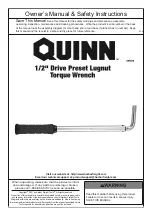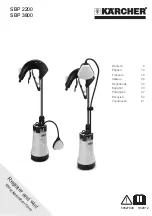
SP20TNS, SP30TNS, SP50TS
4
Rev. 05/10/21
7. Install the pump handle (25) in the handle receiver (48) by
depressing the spring loaded button (26) in the handle, slide the
handle in the receiver until the button pops into the hole in the
receiver.
8. Install the plungers (44) in to the corresponding holes of the
plungers that are located on each side of the press frame
assembly (4).
9. Install the handle storing bracket (55) on the side of the press
frame assembly as shown in the exploded view press drawing.
Secure the bracket to the press frame with the hardware (11 and
12) provided.
10. Install the lock knob in the cylinder assembly (8) and tighten when
the cylinder assembly is moved into the desired work position (30
and 50 ton presses only).
11. Install the locking knob on the side of the press guard but do
not tighten (50 ton press only). 20 and 30 ton press guards are
available as optional equipment. Remove the clear polycarbonate
shield from the guard and remove the protective paper. Slide
the shield back in the guard with the shield holes entering the
guard first. Secure the hand grip to the holes in the shield using
the hardware provided. Do not overtighten. Position the movable
bolster (18) into the desired work position and install the press
guard on the bolster by inserting the guard's locating pins in the
keyholes of the bolster. Make sure the guard is locked in place in
the bolster’s keyhole slots.
12. Find a space in the shop to anchor the press to the floor. The
space should be free of traffic and any obstructions that could
prevent shop press operation. The ASME PASE-2019 Standards
require the shop press to be securely anchored to the shop floor.
This can be accomplished by using an anchor bolt or similar
method to secure the holes in the press’s foot base assemblies
(10) to the shop floor.
OPERATING INSTRUCTIONS
1. Tilt the dust cover (40) on the pump assembly side of the press
back away from the top of the pump assembly’s reservoir. See
figure 3. Lift the plastic vent plug straight up from the reservoir
but do not remove. Pliers may be necessary to lift the vent
plug up. Be careful not to overextend the vent plug to prevent
breakage. Close the dust cover (40).
④
Vent Plug
Release Valve
Knob
FIGURE 3
2. Turn the release valve knob ½ turn counterclockwise from
its closed position. Activate the pump handle (25) ten full
incremental pump strokes.
3. Turn the release valve knob clockwise until it stops and the press
is ready to use.
4. Determine the work to be accomplished and position the
movable bolster (18) to the press frame assembly (4) at the
desired height. Secure the movable bolster with the bolster
locating pins (16) and retaining rings (7). Slide the (8) movable
cylinder assembly (30 and 50 ton presses only) to the desired
position and lock in place with the lock knob. Position the pair
of arbor plates (19) on the movable bolster (18) in the desired
location if needed.
5. Determine the plunger (44) needed to accomplish the work.
Exchange of plungers can be accomplished by removing the
knurled knob from the set screw as shown in figure 4. Back out
the set screw until the existing plunger can be removed. Install
the new plunger and secure with the set screw. Thread the
knurled knob on the set screw and tighten to prevent the set
screw from coming loose.
Set
Screw
Knurled
Knob
FIGURE 4
6. Always use a press guard to prevent any possible injury or
property damage from a flying object(s).
7. When operating the press make sure to read the inner ring of the
force gage to determine the force being applied. The plungers
(44) come in different capacity ratings. Some press capacities far
exceed some of the plunger capacities so the force gage should
be used to prevent the plungers from being used beyond their
rated capacities.
8. Set up the work to be accomplished in the press. Make sure the
setup is stable and the plunger (44) will not be subjected to any
off-center or side loads. Make sure the press guard is in place
and the operator is using protective eyewear. Turn the release
valve knob clockwise until it stops and proceed with operating
the pump handle.
OPERATING MANUAL FOR SP20TNS SP30TNS SP50TS




































